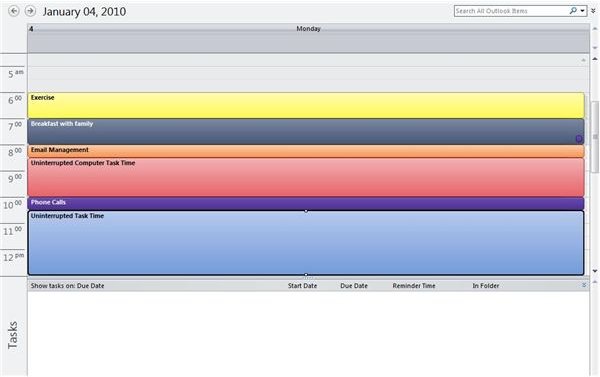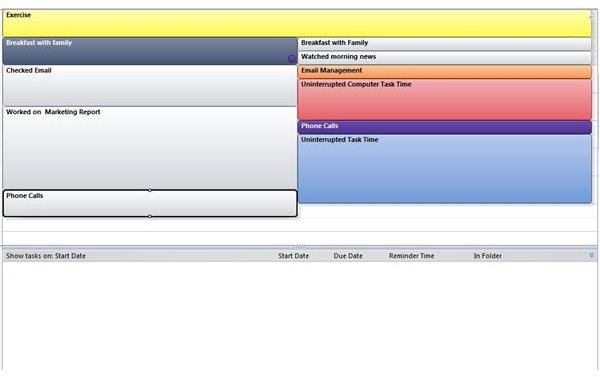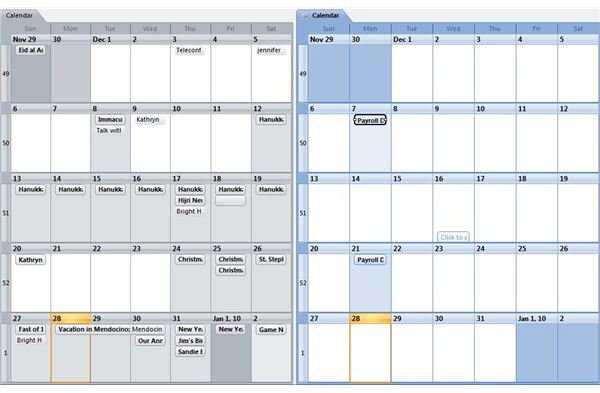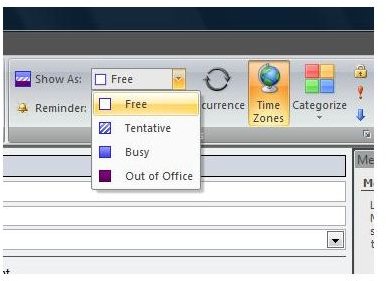Using Microsoft Outlook's Calendar Application
Outlook Calendar Basics
When it comes to managing your time, using tasks helps you organize what needs doing and using the calendar helps you to get it done. In the tasks study guide, I mentioned things tend to not be completed if they are not scheduled. Moreover, you will want to keep track of all of your appointments, meetings, and events that occur in your schedule.
To get started, you will want to enter in all appointments, meetings, and events that you already have scheduled. There are a few different ways to go about this:
- Open a new calendar item by keying in control+shift+A
- Open a new calendar item by clicking on a time slot in the day or week view when in the calendar folder
- Open a new calendar item by double clicking on a date in the to do bar
Once you have opened a newcalendar item, you have a choice to make. Is the calendar item an appointment, a meeting, or an event? An appointment involves just you and a specific time. A meeting involves you, others, and a specific time. An event lasts all day. Once you’ve made this decision - check or uncheck the all day event box. Set the start time and the end time for appointments and meetings. You can add in a location for the calendar item and you can add notes as you see fit. If it’s a meeting that’s already been scheduled, you won’t want to send invites out again for the meeting. If the meeting hasn’t been scheduled, you can send an invite that will place the meeting on your calendar once it’s been confirmed.
Sharing a Schedule
When trying to schedule a meeting with others, you may wish to share schedules to make this process easier. To prepare appointments, meetings, and events in your calendar for sharing, you will want to click on the drop down menu adjacent to “Show as.” You can select “Free,” “Tentative,” “Busy,” or “Out of Office.” If you make this a regular part of your calendar item regimen, you will be ready when you need to share a schedule.
Sharing your schedule is different from sharing a calendar in Outlook. When you share your calendar, you share the iCal file. When you share your schedule, in order to set up a meeting, Outlook takes your already lined up appointments, events, and meetings and displays your “Free” times for others. When you send an email inviting other participants to the meeting, it will display free, tentative, busy, and out of office times for each of the participants in the meeting.
Find out more tips on how to manage your calendar and your time on page 2.
Color-Code Your Life
Microsoft Outlook contains categories that allow you to color code different types of tasks, emails, and even appointments. By using the color-coded categories, you can see at a glance whether you are spending enough time with family and friends, work, studying, etc. Here are some suggestions for color-coding your appointments, events, and meetings:
- Holidays
- Vacation
- Family
- Friends
- Work
- Clients
- Errand
- Education
- Uninterrupted work time
By keeping the different roles in your life straight, you can view at a glance (by the colors appearing on your calendar) what you are doing. You will, of course have times that are more family heavy or work heavy than other times - but this should be a small part of things.
Also by color-coding your schedule, you’ll know at a glance whether you have a meeting that day, whether you’ll need to go into the office, or if you will need to take you laptop with you. To create custom color categories, either right click on your calendar entry and select “All Categories” or double click the entry, click on “Category” then “All categories.” Select your colors and assign each category a color.
Tasks and Task Requests in Calendar View

If you’ve already optimized your Outlook tasks, you will see that tasks appear at the bottom of your screen on the days you have set them to appear (with start and end dates). You will also notice that your tasks have been pre-categorized for you. If a task needs to be completed at a particular time, you can drag the task from the task list in the day or week view and up to a specific time on the calendar. For example, if you scheduled uninterrupted work time from 8:30-10, perhaps you would drag and drop a computer related task into this area. By scheduling your tasks this way, you can help to ensure that the tasks get done - and that you haven’t scheduled too many tasks into too small a time period.
You can also create tasks in the calendar view. At the bottom of the tasks area in calendar view, you will see a white bar. This white bar allows you to do three things: Simply type in the white bar or select “Create New Task” when right clicking to add a task you may have forgotten. Alternatively, you can right click and assign a new task to a co-worker. Finally, you can arrange the tasks in the bar.
Another useful function of the task view in calendar view is that you are able to see tasks on the days they were completed with strike through marks. This can be useful for creating an end of the week or month status reports on client projects.
Creating a Time Map
A time map is a representation of how you spend your time on any given day. Before you aim to create a better schedule for yourself, it is useful to track the current ways that you spend your time. A time map helps you to do this. You can create a time map (and have it be private) in Microsoft Outlook. First, decide whether you want to track your time in 15, 30 or 60 minute intervals. Next, for each activity, you will enter in how much time it took - in your calendar as an appointment occurring in the past. Do this for every activity - and be honest, nobody will see your time map. To mark it as private, simply open each appointment and click “Private” in the upper left-hand corner. You should track your time for a full week this way before attempting to reschedule your workdays. Don’t forget to insert time like commuting and breaks.
Managing Your Time with Outlook Calendar

Now that you know how you spend time vs. how you want to spend your time (or estimate that you will spend your time), you can create a more accurate schedule. Julia Morgenstern’s book Time Management from the Inside Out suggests that before creating a schedule, you understand your motivations for creating that schedule. Do you need to carve out more time for your children? Do you feel swamped at the end of every month? By understanding why you are revamping your schedule, you can find the motivation to stick to the schedule.
Look at your time map and ask yourself for each item, “Is this item a necessary to x, y, or z” with x y or z being whatever goals or strategic objectives you have set for yourself. If it is not necessary to any goals or strategic objectives, why is it on your schedule? Next, ask yourself “Is this the best time for this task? If not when would be?” Once you’ve answered these questions, your calendar will be taking shape. Make sure to schedule down time every day - time that is unstructured. This helps prevent stress and burnout. If something doesn’t get done (i.e. a task, it will carry over to the next day.) You can also reschedule meetings and appointments by dragging and dropping the item into the new slot.
Using Multiple Calendars to Coordinate Family Activities

Finally, you can use multiple calendars - perhaps one is your time map, one is your daughter’s schedule, one is your wife’s schedule. This helps you to coordinate your schedule with other people’s. Does your daughter have a soccer game? By sharing calendars as iCal files, you can easily keep up to date on others’ schedules. To create a new calendar file, right click on the calendar item and select “new folder.” The new calendar will be a different color - you can view calendars side-by-side or stacked on top of each other. View the calendar tab and select the calendars you would like to view simultaneously. You can now add important events to your calendar by dragging and dropping an appointment from one calendar to your own.
This post is part of the series: Microsoft Outlook Study Guides
This series covers the different features Microsoft Outlook offers users. Find out tips on using your email effectively, how to manage tasks and small projects, and how to keep on top of your contacts in Outlook 2007.
